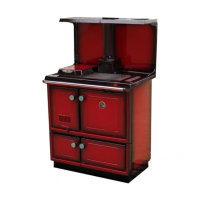DOWN DRAUGHTS
However well designed, constructed and posi-
tioned, the satisfactory performance of the flue can
be adversely affected by down draught caused by
nearby hills, adjacent tall buildings or trees. These
can deflect wind to blow directly down the flue or
create a zone of high pressure over the terminal.
A suitable anti-down draught terminal or cowl will
usually effectively combat direct down blow but no
cowl is likely to prevent down blow due to high
pressure zone. Ensure that any cowl used will not
restrict the flue exit. (See Fig.5)
Horizontal runs more than 305mm (12”) and 90
o
bends numbering more than 2 per installation
should be avoided.
If it is necessary to offset the chimney the recom-
mended angle is 60
o
to the horizontal and the statu-
tory minimum is 45
o
. (See Fig.4)
CHIMNEY CLEANING
Whichever type of flue is chosen there must be
cleaning access to the whole of the flue system.
The flue of the chimney will need to be cleaned
regularly. How often will depend a lot on how your
Cooker is run, but to start with, make a point of
inspecting the flue system every one or two weeks.
This period may well be extended as time goes by
if there is little sign of deposits. Some people find
they only need to sweep the flue every six to eight
weeks.
HEARTH CONSTRUCTION
When a non-combustible floor surface is not avail-
able, then we recommend that the cooker be
placed on a slab of pre-cast concrete 7.5cm (3”)
thick or a slab of another insulating material. This
hearth must extend 300mm (12”) to either side of
the appliance and 400mm (16”) to the front.
CONNECTIONS
A L L FLUE CONNECTIONS MUST BE THOR-
OUGHLY SEALED. Blocked chimneys are dan-
gerous, use only recommended fuels, keep chim-
neys and flueways clear, read the operating
instructions.
STANLEY CAST IRON PIPES ARE HIGHLY
RECOMMENDED FOR INTERIOR USE.
WHERE THE APPLIANCE SPIGOT OR FLUE
PIPES PROTRUDES INTO THE CHIMNEY, CARE
SHOULD BE TAKEN TO ENSURE THAT IT DOES
NOT BLOCK THE CHIMNEY.
5
Fig.4
Fig.5
USE OF EXISTING FLUES OR CHIMNEY’S
An existing flue pipe or chimney that has proven to
be satisfactory when used with another solid fuel
appliance can normally be used for this appliance

